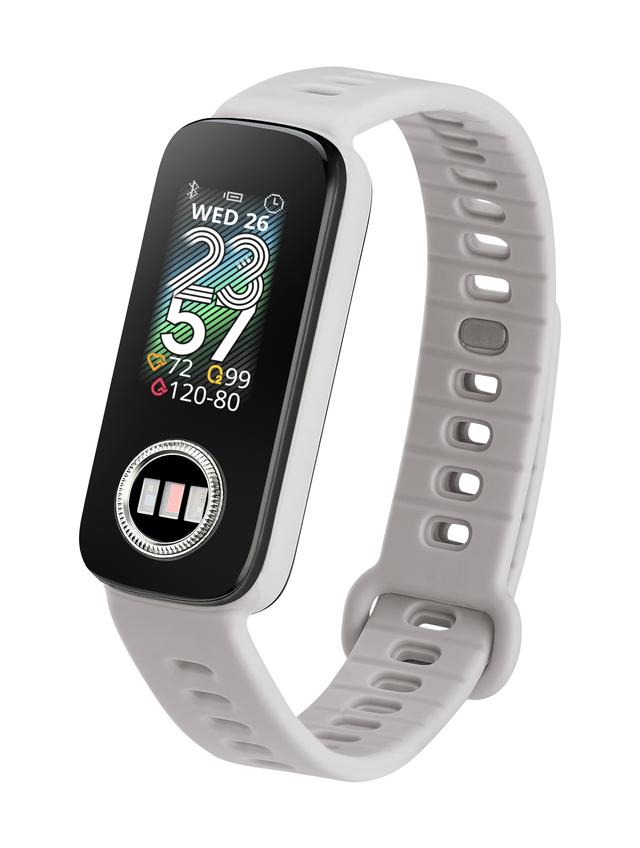World’s first smart wrist band with one-touch Pulse Transit Time and blood oxygen level measurement
- World’s first smart wrist band to offer one-touch Pulse Transit Time and blood oxygen measurements
- Built-in photoplethysmography (PPG) and electrocardiography (ECG) sensors enable continuous monitoring of vitals throughout the day
- Real-time measurements can be taken by touching the façade sensor for 20–25 seconds
- Provides accurate Pulse Transit Time, pulse oximetry (SpO2), heart rate measurements, plus distress index and sleep tracking

SYDNEY, Australia, May 10, 2023 — ASUS today announced VivoWatch 5 AERO, the world’s first smart wrist band that offers one-touch Pulse Transit Time (PTT) and blood oxygen measurement. VivoWatch 5 AERO features built-in photoplethysmography (PPG) and electrocardiography (ECG) sensors that continuously monitor the wearer’s vitals throughout the day, and it syncs with the ASUS HealthConnect app to provide a comprehensive overview of health stats.
Built-in ECG and PPG sensors
ASUS VivoWatch 5 AERO is the world’s first smart wrist band with built-in micro-electrical (for ECG) and optical (for PPG) sensors. The wearer only needs to select the function on the watch and place a finger on the sensor for accurate PTT and blood oxygen measurement in real time. VivoWatch 5 AERO can measure heart rate during rest, exercise, and sleep, and provides the wearer with a distress index.
Sleep quality affects heart health. VivoWatch 5 AERO even analyzes sleep patterns and snoring at night to help users better understand the quality of their sleep.
Users can place their forefinger on the dual sensors of VivoWatch 5 AERO for 30 seconds to get detailed recordings on the ASUS Healthy Group data sharing feature. They can then use the ASUS HealthConnect app to share the results with their doctor[1].
Pulse Transit Time (PTT) and Pulse Oximetry (SpO2) measurements
ASUS VivoWatch 5 AERO includes a variety of monitoring modes and a graphical display Pulse Transit Time can be used to evaluate the condition of the heart and cardiovascular system. VivoWatch 5 AERO uses the time difference between signals collected by its ECG and PPG sensors to calculate flow speeds in arterial blood vessels and pressure conditions generated by the vessel walls during regular contraction and relaxation of the heart. Real-time PTT measurements can be done by placing an index finger on the watch face for 20–25 seconds. The sensors on the back of the VivoWatch 5 AERO watch face measure PTT and blood oxygen automatically every hour, and heart rate every 10 minutes. In sleep mode, it tracks the heart rate every minute.
Additional features
ASUS VivoWatch 5 AERO is dust-proof and features 5ATM water resistance up to a depth of 50 meters. It features multiple workout modes for jogging, treadmill runs, swimming, yoga, and more. Built-in GPS, IC antennas, and a G-sensor accurately track jogging and hiking routes, even if the wearer doesn’t have a mobile phone at hand. Convenient features include incoming call notification, message alerts, idle alerts, timer, medication reminders, and more. VivoWatch 5 AERO features a 16 mm interchangeable band, magnetic charging, and provides up to seven days battery life in power saving mode.
ASUS HealthConnect app
The ASUS HealthConnect app analyzes the data collected by ASUS VivoWatch 5 AERO and provides the wearer with insights about their health. Users can use the app and share the collected data with friends, family, and health professionals. Additionally, ASUS HealthAI within ASUS HealthConnect provides the wearer with personalized tips[2] on healthy habits and management.
With ASUS HealthConnect downloaded on their phone, users can also use VivoWatch 5 AERO as a Bluetooth® camera shutter remote.
[1] ECG availability may vary by region.
[2] ASUS HealthAI uses collected data to assess the wearer’s personal health. To get the most out of HealthAI, VivoWatch 5 AERO should be worn during daily activities and at night during sleep, and the PTT Index measurement feature should be used at least once a day. At least a week’s worth of data is required.





